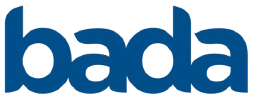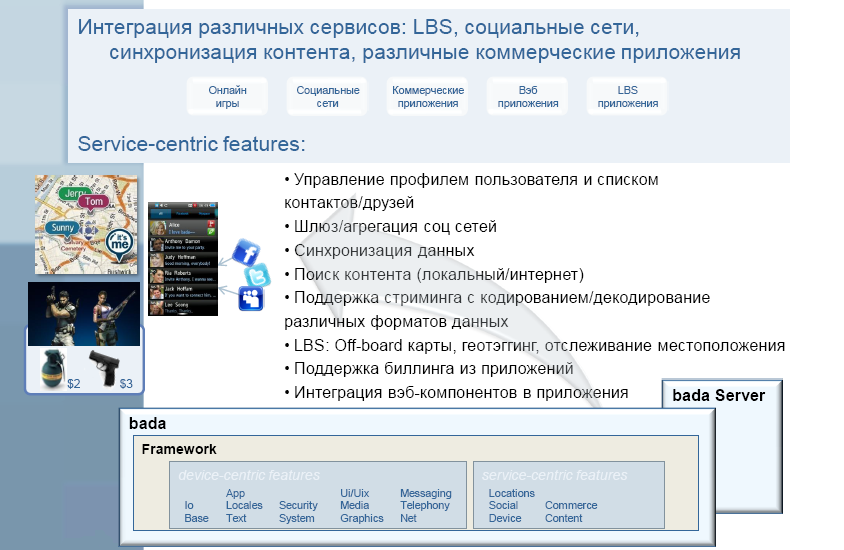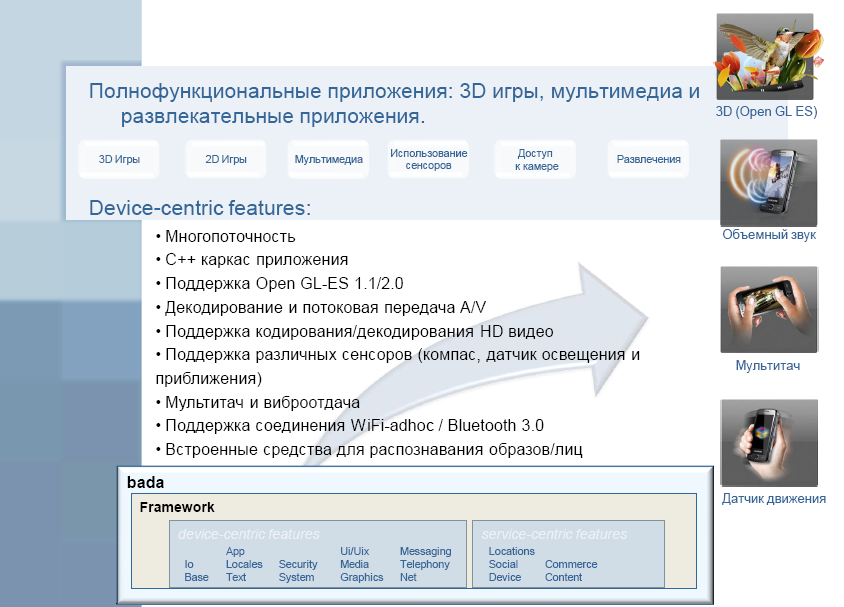Bada. Interview with Oleg Budegechiev and report on the visit to the round table at Samsung FORUM 2010
 Bada is a new mobile platform developed by Samsung and announced by it on November 10, 2009, based on ten years of experience in developing and developing the SHP platform (Samsung Hand-Held Platform). In this review, we will try to give full information on it at the moment that is interesting both to potential software developers for this platform and to potential owners of the first mobile device on it - Wave S8500 , expected on the Russian market in late April - early May.
Bada is a new mobile platform developed by Samsung and announced by it on November 10, 2009, based on ten years of experience in developing and developing the SHP platform (Samsung Hand-Held Platform). In this review, we will try to give full information on it at the moment that is interesting both to potential software developers for this platform and to potential owners of the first mobile device on it - Wave S8500 , expected on the Russian market in late April - early May.Bada - a mobile platform or mobile OS?
At the moment, this is probably the most pressing issue that concerns both potential developers and ordinary users of a new company development.

')
From the above graph, it becomes clear that Samsung is positioning its new development as an open mobile platform, along with Andorid solutions and Apple products. Let's now take a closer look at the platform itself:

Kernel
If the theater begins with a hanger, then any software solution for modern phones begins with its core. In the case of bada, the kernel, as seen above, can be almost anything, and its choice is due only to the hardware platform used.
Device
At this level, the basic functions of the hardware platform and the OS kernel are implemented: graphics, UI fundamentals, telephony, data transfer protocols, multimedia support (camera, audio-video formats). Logically, this is an intermediate level (middleware) between the OS kernel and higher levels, which is necessary for translating hardware-dependent functions to open APIs and hardware-independent software components.
Service
Realization of functions and online services (interaction with bada service server). At this point it is worthwhile to dwell in more detail, and therefore let us turn our attention to the image below:

As you can see, at this level, Samsung is already independently implementing the lion’s share of the functionality that many users of smartphones and other mobile devices had to add to their phones themselves.
App Framework
At this level, support is provided for open APIs and functions in C ++ inherited from previous layers. In other words, installation of native applications (applications developed specifically for the bada platform) will be available to users:

With this, I would like to finish the first part of the review, aimed at the first and general acquaintance with the platform, and move on to more specific and pressing issues, answers to which were received both at the open round table for the press during the Samsung FORUM 2010, and in private communication with Oleg Budegechiev, product manager at Samsung. Boldo and italic will simultaneously highlight the questions themselves, just in italics - my comments, and plain text, respectively, will directly highlight the answers of Oleg.
Interview with Oleg
How many applications can be simultaneously run on bada?
At the moment, the developers stopped at one bada-application and one java. Theoretically, we could have made any number of applications running at the same time, but still chose to follow the path of minimalism and increase the potential of devices in accordance with the requirements of most users and ergonomic considerations.
The platform is aimed primarily at ordinary users, and they, for the most part, do not even distinguish a widget from a native application. In the future, if there is such a need, we certainly can change and supplement the platform for the specific needs of consumers.
Tell us in more detail about the widgets, how they will be implemented in the platform and what is hidden under this concept in the company.
The so-called widgets are already well known to users both from our own previous developments in the field of mobile devices, and from the products of other companies. We did not begin to invent anything new; understanding of the widget remains classic - this is a small application that performs any specific applied role. An example of such applications: clock, weather forecast.
We have somewhat changed the moments already familiar to users, which have become generally accepted in our previous developments. Now the widgets have standard sizes and are rigidly attached to some kind of “grid” on the phone’s “desktop”. Here you can draw an analogy with the placement of the icon on the desktop in computers running win-systems (arrange icons / align by grid).
Also added the ability to combine widgets, making them more functional. Here is an example of combining the above mentioned clocks and the weather forecast, just the clock on the left, the clock on the right + the weather forecast

Should I separate widgets from bada applications?
Yes, definitely. In a conversation about the simultaneous operation of applications, it was specifically about native and java-applications. The number of simultaneously launched widgets, as far as I know, is limited only by the hardware capabilities of the device and free space on its “desktops”.
Ideologically, they are something like java-applications, only of a higher level, as java-applications run inside the java virtual machine, and widgets inside the widget engine, which is essentially a multi-window browser, and all widgets are mini pages.
And how many desktops are provided in the phone?
The working space of the platform is divided into two zones: desktops and menus. This is done solely for ease of operation and ease of navigation through the device. The number of both is 10.
It is rumored that the company demands to develop applications for all platforms used in its devices. Is it so?
No, this is not true. If the developer wants to release his application only under bada (well, or under win mobile), then this is his right.
But after all, does bada also have a division into levels according to platforms?
Yes, it's true. As the developers promise, there will be several reference platforms: an entry-level platform, a mid-level platform and the flagship Hi-end platform. But since it is obvious that these platforms will be used on different hardware solutions, for example, using hardware support for Open GL ES2.0, the company does not intend to put forward demands for porting applications to all platform options.
The only thing that is known for certain about additional difficulties in the development of applications is the fact that for different screen resolutions you need to recompile and redesign the UI.
Tell us about the UI, what's new in it and what “zest” do users expect?
The platform will use the new interface - Touchwiz 3.0. I will list its features:
- Integration of Web / Flash objects
- Sensor support, vibration feedback, etc.
- Calling an application from an application
- Setting 3 bottom soft keys
- Integration of social networks in the phone book
- Ability to send a message directly from the phone book (the conversation is again on social networks and IM)
- Calling the subscriber / sending SMS in one touch
- Pop up messages
- Changeable menu themes
So far, I have not held enough time in the hands of any device based on this platform? asking me for details about everything above is useless :)
Will there be some kind of “repression” in relation to developers and their software, as for example was the case with Apple and Skype? Tell us more about the development of software usage for the platform in general.
I will answer in order. No, the company at the moment is absolutely not tuned to the policy of “repression”, the development orientation is directed primarily to the free market, and not the market of cellular network operators.
As for the picture as a whole, then everything is simple:
- The developer develops an application using the provided SDK (based on Eclipse, debugging of the application is possible both on the emulator and on the real device). Also on developer.bada.com, registered developers are provided with technical support, documentation and code samples.
- The company checks its development and in case of a successful evaluation puts it on Apps .
- The user gets the opportunity to download this application through the phone or through a special application on the computer - Samsung Kies.
- The developer gets access to statistics, billing and other obvious things, like user feedback.
About the possibility of obtaining the SDK at the moment I already wrote here .
As for more detailed information for developers, we will publish it as soon as possible.
For which operating systems is the SDK currently available?
At the moment only for win. There will be a sufficient number of users who want to develop their applications in other operating environments - we will try to solve this issue in their favor.
Will Apps be common to all platforms used in the company?
So far there is no definite solution on this issue, everything depends on our developers.
How will the payment of purchases in Apps?
Currently bada has debugged billing for credit cards and debugging billing via sms. The second option is likely to be also available in the near future, since the company already has some experience with operators in this field.
At the moment, mobile market players in our region specifically are generally unhappy with how software is purchased through payment by sms - too many problems this service causes. The bada platform, or rather its functionality in terms of billing via sms, is in a sense elicited from us by cellular operators.
I confirm that I bought a Samsung phone as a gift for the new year, and the demo versions of the games were pre-installed in it. An automatic (not sure, but not the essence) sending message was inserted into each game, after which the code to unlock the game comes. The cost was around 100 rubles, and indicated for all major operators directly in the game.
In the platform, as I understand it, GPS support is already built in. Who exactly will you collaborate on the cards?
Yes, that's right, there is GPS support, but you should not forget that not all hardware platforms will be equipped with it. As for the supplier of cards, we do not have a clear answer yet - negotiations are underway.
Tell as much as possible about the so-called bada service server, how “secret” will it be to work with it?
The question is serious, so I will try to give a detailed answer. There are two options for implementing social hub (a kind of common node in the phone for the integration of social networks and IM protocols):
- pull (constantly polling the server for new events)
- push notification (the server independently notifies the device about new events on the other side of the network)
So, the pull method implies data encryption (the algorithm and the key length are not ready for you to name now), and to implement push messages, support from the operator is needed. And here inevitably there are SORM requirements, about which so far we are also not ready to speak substantively, since so far there is no final agreement with all the parties.
Regarding the storage of user data - this will not happen, the data will go "through" bada service server. Passwords, in the case of third-party services, will also not be stored only on the device and transmitted to servers only as a hash. In the case of services provided by Samsung (for example, access to Apps), passwords will of course be stored on servers - this is more logical and true.
I personally would not worry about SORM, since we all are already subject to this system’s attention to one degree or another, and it’s unlikely that when discussing these issues with the operator, any new requirements from the authorities will come up.
Will the phones adapt to a specific, Russian consumer? If so, how will it be expressed?
Yes, the phones will definitely adapt to our local realities. I cannot answer the question more specifically yet - all this is still in the process of development.
Will the company use a common name for a new type of mobile device, just like Apple or Microsoft?
No, one phone is one name.
Can we expect any more new bada-based models this year?
Yes, and more than once.
Are there already lists of ready-made applications and widgets?
Yes, they are, but at the moment there is no definitive list of developers who have expressed a desire to work with the platform at the moment, and therefore it is difficult to say something exactly. But on March 29, Samsung Bada Developer Day was held in St. Petersburg, and we hope that in the near future the picture will become clearer.
How do you see the phone market this year?
First, I want to say right away that although we rarely make mistakes in the expectations of movements in the market, we are still ready to answer only directly for ourselves. Secondly, we personally have the most highly optimistic hopes for the smartphone market, in 2010 we expect sales of about 10 million units on bada worldwide and a gain of about half of the smartphone market specifically in Russia.
By smartphones, I currently understand both devices with the old principle of operation (minicomputer) and with the new one.
And finally, I would like to ask the main question for the consumer - what price will be set on Wave at the time of its entry into the Russian market?
We plan a figure of 20-22 thousand rubles.
Instead of conclusions
The first thing that struck me when analyzing the information received was the fact that mobile device manufacturers decided to move away from the “mobile device = smartphone = minicomputer” paradigm. As we were assured by the developers of the company and its PR department, no one of course is going to abandon smart phones in their pure form, based on such time-tested operating systems as windows mobile and Symbian, but in general, the market has come to the point where purchasing power most users, their requirements for functionality and prices for smartphones (in other words, for high-performance hardware and software) approached each other for a minimum distance, while users' ability to distinguish between l smartphone from a regular phone and understand the difference between them and remained at a low level.
And, according to Samsung, this is an absolutely normal situation. Just like most motorists (although this apparently still cannot be attributed to Russia :) at the moment is already weakly imagining the stuffing of their cars (do not forget that repairing many cars is no longer possible in Uncle Vanya’s garage conditions), so the majority of users shouldn’t worry about filling the functionality of your mobile phone or device, if you like.
Watching the market of cellular devices, it should be noted that not only Samsung is moving towards such trends in the development of software products. I will not now enumerate all the similar points, but many of you will most likely notice in time the same thing as me. Namely, a new class of mobile devices is allocated from the phones, aimed at modern users, on the one hand actively using the Internet capabilities and on the other hand, they do not want to delve into the subtleties of settings, compatibility and other specialized details of online work.
Samsung’s developers also emphasize that the changes have not matured overnight, but are the result of long and painstaking work in all directions. In this, of course, the company has helped and will be helped by experience with other mobile platforms and operating systems. Separately, it is worth highlighting such platforms as Star and Jet, they have been used by the company in their devices throughout the past year and have become a kind of springboard on the way to bada, already with their functionality covering 70-80% of all user needs in the functionality of mobile devices.
useful links
Developer site: developer.bada.com
Announcement of Samsung Bada Developer Day: habrahabr.ru/company/samsung/blog/87725/
Photo reports about visiting Samsung FORUM 2010: from Bumburum and from me .
PS: In this review I tried to give only general information on bada and issues related to this platform. Details such as playback of HD-video, support for DivX and XviD, video editing and audio editing and instant uploading results of work in the Internet and much more will be discussed in subsequent reviews of specific devices. Personally, I hope to hold one of them in the very near future :)
So far, I can offer you a video with the online release of the Wave S8500:
Source: https://habr.com/ru/post/89216/
All Articles